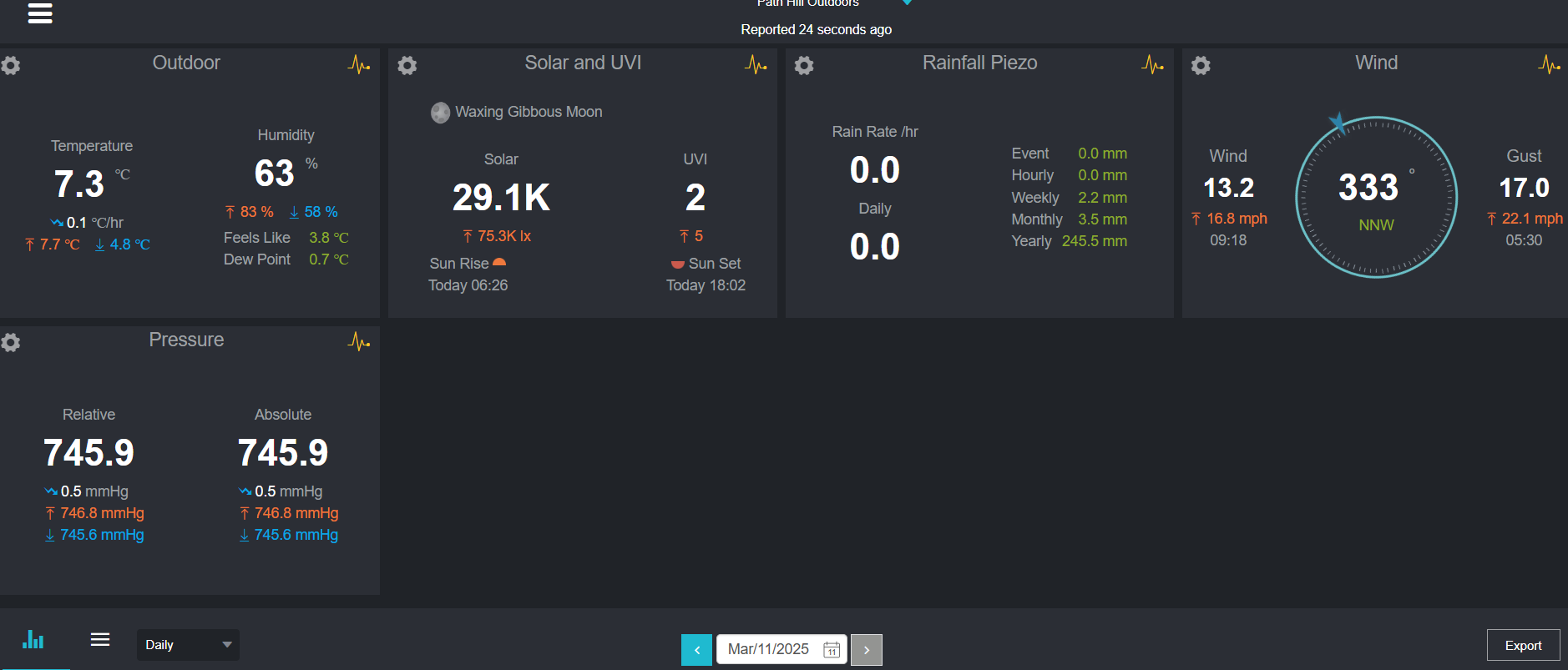Weather and Water Monitoring
The Weather at Path Hill
In 2024 we installed a weather station at Path Hill. This gives real time and historical information on the following
- Outdoor temperature (also ‘feels like’ measurement) oC
- Wind direction/wind speed/gust speed mph
- Humidity %
- Rainfall daily/event/hourly/weekly/monthly/yearly
- Barometer readings mmHg
- Sunrise and sunset times
- uV light and solar radiation
- Moon phases
This data is available on the Ecowitt website. To access please click on the web address or scan the QR code
https://www.ecowitt.net/home/share?authorize=18RHXF


River Water Monitoring
River water monitoring is one of the many activities on offer to our students. They can find out how we impact our rivers in two ways
- investigating aquatic life – the greater the variety of life, the better the quality of the water
- carrying out tests on river water that indicate different levels of chemicals
From these tests we can make a conclusion about the pollution levels in the River Thames and discuss action that needs to be taken to improve the water quality.
The following parameters indicate water quality. Students measure them using strip indicators, indicator tabs and meters.
Nitrates
Nitrate is an important nutrient for plants but too much allows certain plants such as algae, to dominate. Nitrates are used in fertilizers and put on the surrounding fields. When it rains the nitrates can flow from the land into the rivers.
Low Quality – > 4ppm. If it is over 10ppm then it is very low quality
Average Quality – 3 to 4 ppm.
Good Quality – 1 to 3 ppm.
Nitrites
Nitrites are toxic to aquatic plants and animals
Low Quality – > 5ppm.
Average Quality – 1 to 5 ppm.
Good Quality – 0 or less than 1ppm.
Ammonia
Ammonia occurs naturally in water at low concentrations. High concentrations of ammonia in the River suggest runoff from agricultural land as ammonia is present in fertilisers.
Low Quality – more than 0.39ppm
Average Quality – Between 0.39 and 0.1 ppm
Good Quality – Less than 0.1ppm
Phosphates
Phosphate is, alongside Nitrate, one of the most common polluters of rivers. High concentrations of Phosphate encourage the growth of algae and duckweed which in turns blocks sunlight and lowers the level of oxygen available to other aquatic life.
Low Quality – More than 1ppm
Average Quality – 0.15 to 1ppm
Good Quality – Less than 0.15ppm
Electric Conductivity
This is a measure of the amount of minerals dissolved in the River water. Too many minerals (high electric conductivity) will render the water undrinkable and unsuitable for watering plants. The water may taste salty. As the River Thames passes through chalk landscapes there will be higher electric conductivity than a river passing through sandstone of rock less susceptible to dissolving in water. EC is related to temperature. The higher the temperature the greater the conductivity.
Low Quality – More than 700 micro-Siemens per centimetre
Good Quality – 150 to 700 micro-Siemens per centimetre
Clarity
A measure of how much sunlight is penetrating the water and the effectiveness of photosynthesis. Water can become turbid after heavy rain (run off from surrounding fields) and can indicate high Nitrate and Phosphate levels.
1. Coli bacteria
This is not measured by Path Hill students. In 2024 there was a citizen science project that measured E. Coli levels in Pangbourne. The results from this community project can be found at https://www.thames21.org.uk/wp-content/uploads/2024/12/Pangbourne-South-Stoke-Water-Quality-Report-2024.pdf
- Coli levels are important as this bacteria can cause illness if ingested.
The amount of E Coli in the river fluctuates according to rainfall. When it rains hard our sewage system can sometimes not handle the extra water. This can cause the sewage to overflow into rivers increasing the E Coli content.
Intestinal Enterococci
Enterococci are found in human and animal faeces, and their presence in water can indicate the presence of other disease-causing pathogens. This can be a health risk for people who swim in or eat raw shellfish or fish from contaminated water.
of the most common polluters of rivers.
Rainfall
Heavy rain may result in the sewage system being unable to cope with excess water allowing raw sewage to enter the river. The weather station at Path Hill Outdoors accurately measures rainfall in the area.

